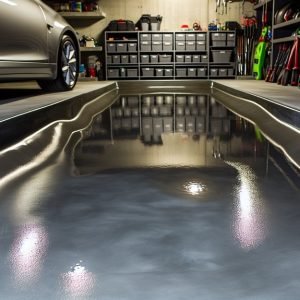Last Updated on October 30, 2025 by teamobn
We often take water access for granted – turning the tap, filling a glass, and drinking without a second thought. Yet, not everyone worldwide enjoys this level of convenience, and even where we do, water quality might not be as excellent as we believe.
Various factors can affect it, from contaminants to environmental concerns and sudden changes in local water regulations or management.
Given the profound impact that water can have on our health and wellbeing, understanding water quality and taking steps to improve your home’s supply are essential steps to improve your home living. Discover more below.
Contents
- 1 Health and Safety: Protecting Your Family from Contaminants
- 2 Preventing Plumbing Issues: Avoid Corrosion and Damage
- 3 Cost Savings: Reducing Expenditure on Medical and Repair Bills
- 4 Understanding Local Issues: Staying Informed about Regional Water Concerns
- 5 Better Taste and Smell: Enhancing Everyday Water Experience
- 6 Environmental Impact: Conserving Water Resources
- 7 Property Value: Increasing the Appeal and Worth of Your Home
- 8 How to Check Water Quality: Simple Tests and Professional Options
- 9 The Importance of Continuous Water Quality Monitoring
- 10 Wrapping it up…
- 10.0.1 1. Health and Safety: Protecting Your Family
- 10.0.2 2. Preventing Plumbing Issues: Avoiding Corrosion and Damage
- 10.0.3 3. Cost Savings: Reducing Medical and Repair Expenses
- 10.0.4 4. Understanding Local Issues: Staying Informed on Water Concerns
- 10.0.5 5. Better Taste and Smell: Enhancing Water Enjoyment
- 10.0.6 6. Environmental Impact: Conserving Water Resources
- 10.0.7 7. Property Value: Increasing Home Appeal
- 10.0.8 8. Checking Water Quality: Simple Tests & Professional Help
- 10.0.9 9. Continuous Monitoring: Adapting to Changes
Health and Safety: Protecting Your Family from Contaminants
Water quality plays a major role in our overall health and well-being. If quality water can help us stay hydrate and contribute to the intake of essential minerals, a drop in quality can lead to severe health problems, including:
- Lead Poisoning: Caused by lead in water, it can harm brain development, especially in children.
- Chlorine Exposure: High chlorine levels can dry out skin and eyes, and create harmful byproducts.
- Bacterial Infections: Result from bacteria like E. coli in water, causing illness and digestive issues.
- Gastrointestinal Issues: Contaminated water can cause diarrhea, vomiting, and stomach cramps.
- Skin Irritations: Contaminants like chlorine can lead to rashes and skin inflammation.
- Hair Damage: Hard water makes hair brittle and leaves residue, affecting hair health.
- Increased Allergen Sensitivity: Contaminants can worsen allergies or asthma, leading to chronic conditions.
If you suspect lead could be an issue in your tap water, here’s exactly what you can do if your water system contains lead to test, mitigate, and protect your family.
Simply put, poor water quality can wreak havoc on your health. Imagine dealing with persistent skin irritations or unexplained stomach upsets – these issues can impact all aspects of your life, from your sleep quality to your productivity and energy levels. And, if you are unsure what’s causing your health problems, it may be worth getting your water checked.
Be sure to prioritise this factor: clean, safe water is a fundamental aspect of a healthy home environment, for you, your family, pets, and garden alike.
Preventing Plumbing Issues: Avoid Corrosion and Damage
Poor water quality isn’t just unpleasant. It can be harmful to your plumbing system. High mineral content in water, also known as “hard water,” leads to scale buildup in pipes and appliances. This can cause blockages, reduce water flow, and increase wear and tear on appliances like dishwashers and washing machines. Over time, the cost of repairs can add up!
Corrosion can also occur when acidic or overly basic water interacts negatively with plumbing materials. This can lead to compromised water quality and potential health risks.
Checking on your home’s water quality is essential to maintain your plumbing in top shape, and, in turn, maintaining your plumbing in top shape can save money on repairs, support a healthier living environment – and, ultimately, keep your home water-efficient!
Cost Savings: Reducing Expenditure on Medical and Repair Bills
When you take steps to improve the water quality in your home, you will also be able to enjoy long-term savings.
Just to get an idea, consider your medical expenses when dealing with illnesses and problems, such as skin irritation, caused by poor water quality. Costly doctor visits and medication bills can add up quickly! What’s more, poor water quality damages household appliances and plumbing systems, increasing repair costs or necessitating replacements.
So, if you are looking to improve your household’s finances, you may want to start right from your water quality!
If your water quality is consistently high, you can reduce these unforeseen costs: your health can benefit and plumbing and appliances function better with clean water. The initial investment in water quality solutions, like filters or regular water testing, is offset by the reduced expenses, helping you build a more cost-effective household over time.
Understanding Local Issues: Staying Informed about Regional Water Concerns
Being updated about local water quality trends should be a priority for any member of the community. You, as a homeowner, should be informed about contaminants that might affect the entire neighborhood. Here, keeping up with local water reports or community meetings keeps you on top of any changes.
Additionally, if you believe that you or your local area have been impacted by changes in water quality, it is important to get informed about ongoing initiatives. According to research, around 45% of tap water may contain one or more “forever chemicals”, like PFAS. These can lead to significant health problems.
For example, studies found a link between PFAS and testicular cancer risks. Understanding localized issues, like nearby agricultural runoff or industrial discharges, empowers you to take the right measures.
Better Taste and Smell: Enhancing Everyday Water Experience
Have you ever noticed an off taste or smell in your tap water? This can be due to common water contaminants like chlorine, sulfur, or organic material residue. Chlorine can give water a swimming pool-like smell, while sulfur often makes it smell like rotten eggs. 
Clean, fresh water enhances the taste and smell of everything cooked and washed with it, from your morning coffee to your vegetables. Not only does improved water quality affect your senses, but it also directly impacts your health! Removing these common contaminants ensures you’re consuming water that’s both safe for your family and enjoyable to drink, which makes it easier to stay hydrated!
Environmental Impact: Conserving Water Resources
As a homeowner, when you use water responsibly, you can minimize pollutants entering the water cycle, reducing harm to ecosystems. For example, minimizing chemical runoff into rivers benefits aquatic life. Similarly, using greywater systems to irrigate your garden or harvesting rainwater can also reduce the demand on freshwater sources.
These practices support sustainability by improving water management in the home, while reducing your household’s footprint. However, before investing in these systems, you’ll want to understand the quality of water in your home, how it impacts your household or garden, and take the right steps to define different water sources for different tasks.
Property Value: Increasing the Appeal and Worth of Your Home
Good water quality is a smart investment for your home. And, for more than a reason:
- Potential buyers are often interested in a home’s water safety and efficiency.
- Reliable plumbing systems and high-quality water indicate fewer repairs.
- High water quality reduces the risk of health issues.
So, whether you are looking to sell your home or trying to improve its market value, you should start by testing the water in your property.
Additionally, if you have noticed that you are struggling to get safe or clean water, you may consider installing a central water filter. This can be an attractive feature in areas where getting safe or clean water is challenging, providing an additional selling point for potential buyers.
How to Check Water Quality: Simple Tests and Professional Options
Ensuring your home’s water is safe isn’t a one-time task, but rather an ongoing commitment to health and safety. After all, water quality can change over time, and you need to be ready to implement emergency measures when needed.
Simple home tests can identify common contaminants, while professional services provide comprehensive analysis. Here are some strategies to keep an eye on your home’s water quality:
- Use at-home water testing kits for quick results.
- Test for contaminants like lead, bacteria, and chlorine.
- Conduct pH tests to check acidity or alkalinity.
- Install a filter on taps or under sinks.
- Regularly clean aerators and faucets.
- Use activated carbon filters to improve taste.
- Consider reverse osmosis systems for better filtration.
- Properly maintain your home’s water softener.
- Stay updated on local water quality reports.
- Hire professionals annually for detailed evaluations.
The Importance of Continuous Water Quality Monitoring
Monitoring your water quality over time is crucial, as various factors can affect it. Events such as heavy rains, droughts, management policy shifts, natural disasters, or even earthquakes can alter the safety and integrity of the water supply.
Regular testing and adjustments ensure that you adapt to these changes, maintaining water safety for your household. Keep vigilant, and your efforts to monitor your water quality will pay off by safeguarding the health of your home and community, boosting quality of life, ensuring you’re always enjoying the best water possible.
Wrapping it up…
Understanding water quality will help you and your family in the following areas:
1. Health and Safety: Protecting Your Family
Water quality directly impacts health. Contaminants like lead, chlorine, and bacteria can cause serious issues, including poisoning, skin irritation, and gastrointestinal problems. Poor water quality can worsen allergies and damage hair. Regular testing ensures safe drinking water for your family, pets, and plants.
2. Preventing Plumbing Issues: Avoiding Corrosion and Damage
Hard water and contaminants can lead to scale buildup, pipe corrosion, and appliance damage. Poor water quality increases maintenance costs and reduces plumbing efficiency. Monitoring water quality helps prevent expensive repairs and extends the life of household systems.
3. Cost Savings: Reducing Medical and Repair Expenses
Investing in water quality solutions, like filtration systems and routine testing, helps prevent costly medical bills and plumbing repairs. Over time, clean water reduces expenses associated with illnesses and appliance damage, making it a cost-effective household improvement.
4. Understanding Local Issues: Staying Informed on Water Concerns
Local water sources can be affected by industrial discharge, agricultural runoff, or harmful chemicals like PFAS. Keeping up with regional water reports helps homeowners take action to protect their health and ensure a clean supply.
5. Better Taste and Smell: Enhancing Water Enjoyment
Contaminants like chlorine and sulfur can make water smell and taste unpleasant. Removing impurities improves the flavor of drinking water and enhances the quality of cooked food and beverages, making hydration easier and more enjoyable.
6. Environmental Impact: Conserving Water Resources
Sustainable water practices, such as rainwater harvesting and greywater reuse, help reduce water waste and pollution. Using eco-friendly systems protects freshwater sources and minimizes environmental harm.
7. Property Value: Increasing Home Appeal
Good water quality makes a home more desirable to buyers by reducing plumbing risks, improving health conditions, and enhancing overall efficiency. Installing filtration systems can be a valuable selling point in areas with poor water quality.
8. Checking Water Quality: Simple Tests & Professional Help
Homeowners can monitor water quality using at-home testing kits, pH tests, and filtration systems. Professional evaluations provide comprehensive insights into potential contaminants, ensuring long-term water safety.
9. Continuous Monitoring: Adapting to Changes
Water quality fluctuates due to weather, infrastructure changes, or natural disasters. Regular testing ensures safe water for drinking, cooking, and household use, safeguarding health and home investments.
By staying proactive, homeowners can protect their families, save money, and enhance their living environment with cleaner, safer water.






